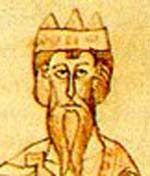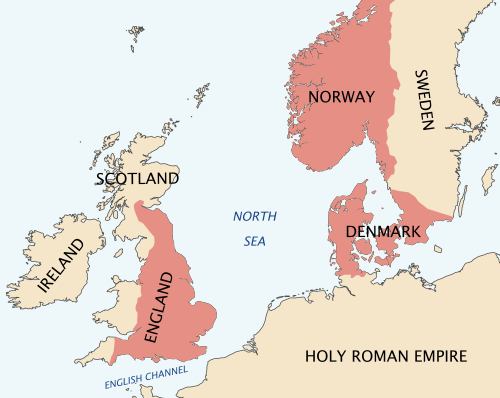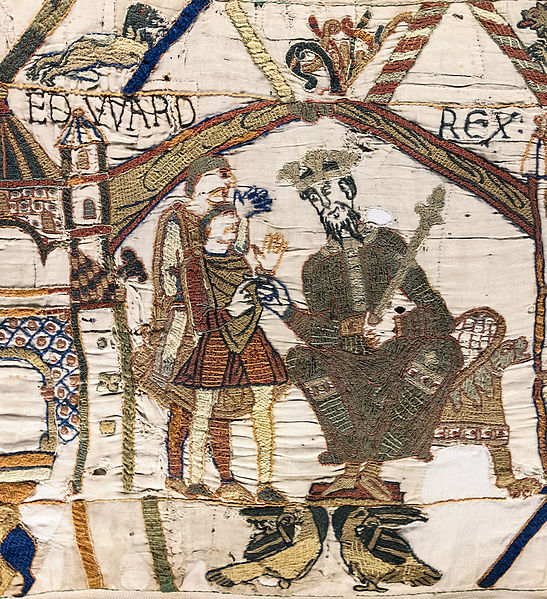Trips Abroad Rome
 |
| Conrad II |
Cnut
attended the coronation in Rome of Conrad II, on 26th March 1027, as
Holy Roman Emperor. Cnut processed across Europe, bestowing munificent gifts at
religious establishments, including the monastery of St Bertin in St Omer. The trip established Cnut as very devout, if
a trifle ostentatious and overly dramatic, possibly being a penance for any
involvement in the murder of Ulf the previous year;
‘In a manner wonderfully
reverent, fixing his eyes upon the ground, and freely flowing forth, so to
speak, rivers of tears. But when the time came when he desired to heap the holy
altars with royal offerings, how often did he first, with tears, press kisses
on the pavement.’’[i]
But it also
confirmed Cnut as a player on the international scene. While attending the
celebrations in March Cnut probably started the negotiations that resulted in the
marriage of his daughter Gunnhilde to Conrad’s heir Henry.
Cnut wrote back to England
informing them of his actions;
 |
| Henry III |
‘Be it known to you, that a
great crowd of nobles was there at the very Easter celebration with the Lord Pope John and
the Emperor Conrad, to wit all the princes of the peoples from Mount Garganus[ii]
to the nearest sea[iii], who have both received
me with honour and honoured me with precious gifts. However, I was honoured
most by the Emperor with various gifts and priceless presents, both in gold and
silver vessels and in cloaks and in extremely precious garments.’[iv]
Cnut managed
to abolish the taxes payable by English pilgrims and traders journeying to
Rome. He also got an agreement to reduce the cost to his archbishops of
receiving the pallium. Conrad and Cnut got on well
together; indeed Cnut and Rudolph, the king of Burgundy, walked alongside
Conrad in the imperial procession, and Conrad gave Cnut a grant of lands in the
Mark of Schleswig.
Trips Abroad Scotland
There
appears to be some dispute about the date of the trip to Scotland[v]. Some sources claim 1027
and others 1031. There is no dispute about the trip; Cnut rode up to Scotland;
which was divided into six provinces, each with their own king. According to
contemporaneous sources Cnut and Malcolm had long been enemies. Malcolm’s son
Kenneth had besieged Durham in 1006. The region remained volatile for a long
time.
‘King Cnut went to Rome, and
in the same year he went to Scotland. The Scottish king
Malcolm bowed to him, and two other kings, Maelbeth and
Iehmarc[vi].’[vii]
It is
possible that Malcolm took advantage of Uhtred’s murder in 1016 and expanded
down into Lothian. Siward[viii], the Earl of Northumbria did not
challenge Malcolm’s expansion into Lothian, but he in his turn expanded his
earldom into the west. Sighvat Thordarsson, who was one of Cnut’s skalds, states that;
‘The most famous princes in
the North from the midst of Fife have brought their heads to Knutr; that was to
buy peace.’[ix]
To undertake
trips of such magnitude shows how very confident Cnut was in his thanes and in
the people of England and his counsellors. The country was left in the care of
the king’s council where Godwine[x], Earl of Wessex, was becoming a
dominant character on the council.
Cnut's Empire
Norway
In 1028 Cnut
drove King Olaf Haraldsson from the throne of Norway and
assumed the title for himself. He made Haakon Eriksson his deputy in Norway.
‘King Cnut went from England
with fifty ships to Norway, drove king Olaf from the land, and secured his
claim on it.’[xi]
In 1030,
when Haakon died, Olaf Haroldsson attempted to regain his throne. After Olaf
was defeated Cnut sent his son Svein Knuttson to rule with his mother Aelfgyfu as regent.
‘King Olaf was killed in
Norway by his own people, and was afterwards made a saint; and this year before
that Hakon, the doughty eorl, died at sea.’[xii]
Aelfgyfu’s
rule was not appreciated by the Norwegians .The taxes she imposed and harsh
laws that were introduced resulted in the regent and her son being expelled
from Norway in 1034. Svein fled to Denmark, where he died not long afterwards.
Cnut’s Last Years
Cnut from a 13th century manuscript
Earl Godwine
came to prominence in Cnut’s last years. His wife, Gytha Thorkelsdottir , was the sister of Cnut’s sister’s
murdered husband Ulf. Godwine attached himself to the rising star that was Cnut
Sveinsson and, unlike Eadric, stayed loyal. Cnut made Godwine earl of east Wessex
in 1018 and earl of all of Wessex by 1023. Sources claim that Godwine fought
with Cnut in Denmark in 1019.
‘He [Cnut] also found 0ut
how profound he [Godwine] was in eloquence, and what advantage it would be to
him in his newly acquired kingdom if he were to bind him more closely to him by
means of some fitting reward.’[xiii]
Glastonbury Abbey
In late 1032
Cnut made a pilgrimage to the burial place of his old rival Edmund Ironside,
buried in the abbey at Glastonbury. Cnut arrived with his entourage on 30th
November and laid a cloak, decorated with peacock feathers, on the tomb. William of Malmesbury records that Cnut was very moved by
the ceremony, calling Edmund his brother.
Most of
Cnut’s actions in his last three years of life are not shown in the written
record, apart from grants of lands to various religious establishments and to
Godwine and others.
Death
In late
autumn 1035 Cnut and Emma were on a royal progress and had visited Sherborne,
where Cnut issued a charter to the church, granting it sixteen hides of land at
Corscombe in Dorset, requesting that the monks offer prayers for him. The royal
entourage then travelled to Shaftesbury. Cnut died on 12th November
1035. The Knytlingasaga gives details of symptoms that could be jaundice.
‘King Cnut passed away at
Shaftesbury; he is buried in Winchester in the Old Minster. He was king over
all England for very nearly twenty years…………..a meeting of all counsellors, in
Oxford……chose Harold to hold all England for himself and his brother
Harthacnut, who was in Denmark.’[xiv]
Emma's son Edward, known as the Confessor
Cnut’s sons
had neither the ability nor personality to hold together the empire Cnut had
forged for himself. His son Harold Harefoot reigned for five years in England,
dying before his brother Harthacnut, (whom Cnut had wished to inherit both
England and Denmark), King of Denmark could launch a planned invasion fleet. In
his turn Harthacnut reigned only two years, before dying. He was succeeded by
Emma’s son Edward[xv]. In Norway Cnut was succeeded by Magnus Olafsson, son of Olaf II.
Bibliography
The Vikings
– Magnus Magnusson – Tempus Publishing Ltd 2000
Queen Emma
and the Vikings – Harriet O’Brien – Bloomsbury Publishing 2005
The
Anglo-Saxon Chronicles – Anne Savage (translator), Colour Library Books 1995
Anglo-Saxon
England – Frank Stenton, Oxford University Press 1997
Cnut – MJ
Trow, Sutton Publishing Ltd 2005
www.wikipedia.en
[i]
Cnut - Trow
[ii]
Mont St Angelo in the then Kingdom of Naples
[iii]
The Adriatic
[iv]
Cnut - Trow
[v]
There are more than one manuscript of the Anglo Saxon Chronicles, there is one
from Abingdon and another from Worcester as well as others
[vii]
The Anglo Saxon Chronicles - Savage
[viii]
Who first appears in the records identifiably in Northumbria in 1033
[ix]
Cnut - Trow
[x]
Father of King Harold
and Tostig, who in
1066 was defeated by Harold at the Battle of Stamford Bridge thus opening the
way for the invasion of Emma’s great-nephew William the Bastard
of Normandy
[xi]
The Anglo Saxon Chronicles - Savage
[xii]
Ibid
[xiii]
Cnut - Trow
[xiv]
The Anglo Saxon Chronicles - Savage
[xv]
Known as the Confessor




No comments:
Post a Comment
Note: only a member of this blog may post a comment.